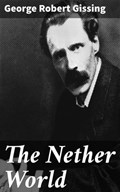In "The Nether World," George Robert Gissing delves into the profound struggles of the working class in late Victorian England. The novel is characterized by its unflinching realism and a poignant narrative style, vividly depicting the stark contrasts between wealth and poverty. Gissing employs a rich tapestry of characters, showcasing their aspirations, despairs, and moral complexities within an oppressive socio-economic landscape. The themes of social injustice, moral ambiguity, and the relentless quest for dignity resonate throughout the text, placing it firmly within the broader literary context of naturalism prevalent during the period. Gissing, a product of his era, was profoundly influenced by his own experiences with poverty and his education, which exposed him to the works of great social reformers. His poignant insights into the plight of the marginalized stem from his empathy for the working class, which he experienced firsthand. Gissing's background as a writer who faced personal adversity enhances the authenticity and depth within "The Nether World," making it not just a narrative but a powerful social commentary. I highly recommend "The Nether World" to readers who seek to explore the intricacies of human character against the backdrop of societal constraints. Gissing's exploration of resilience and despair invites contemplation on contemporary issues of class and morality, ensuring the novel remains relevant and thought-provoking for today's audience.

